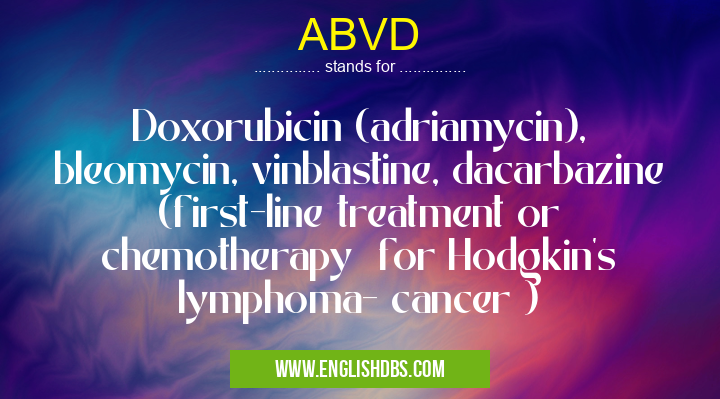What does ABVD mean in MEDICAL
ABVD stands for Doxorubicin (Adriamycin), Bleomycin, Vinblastine, and Dacarbazine, which is a combination of some of the most commonly used drugs used in chemotherapy treatments for Hodgkin’s lymphoma. This particular drug regimen has been in use since the early 1970s and is still considered to be the gold standard in treating this particular type of cancer. In this article, we will take an in-depth look at what ABVD stands for, as well as its efficacy as a treatment option.

ABVD meaning in Medical in Medical
ABVD mostly used in an acronym Medical in Category Medical that means Doxorubicin (adriamycin), bleomycin, vinblastine, dacarbazine (first-line treatment or chemotherapy for Hodgkin's lymphoma- cancer )
Shorthand: ABVD,
Full Form: Doxorubicin (adriamycin), bleomycin, vinblastine, dacarbazine (first-line treatment or chemotherapy for Hodgkin's lymphoma- cancer )
For more information of "Doxorubicin (adriamycin), bleomycin, vinblastine, dacarbazine (first-line treatment or chemotherapy for Hodgkin's lymphoma- cancer )", see the section below.
What Does ABVD Stand For?
As previously mentioned, ABVD stands for Doxorubicin (Adriamycin), Bleomycin, Vinblastine, and Dacarbazine - four separate drugs that have been combined for use in chemotherapy treatment regimens.
Doxorubicin (Adriamycin) is an anthracycline antibiotic derived from Streptomyces peucetius and is one of the oldest forms of chemotherapy agents approved by the U.S. Food and Drug Administration (FDA). It works by damaging or destroying rapidly growing cells such as cancer cells and those involved in forming blood vessels that support tumor growth.
Bleomycin is an antibiotic that breaks down DNA within cells. It is often administered intravenously or via direct injection into the tumor mass itself. It has been found to be particularly effective against Hodgkin’s lymphoma when combined with other agents such as doxorubicin or vinblastine. Together they work by damaging DNA strands within rapidly growing malignant cells while being less toxic to normal healthy tissues than other chemotherapeutic agents available today.
Vinblastine is an alkaloid derived from the Madagascar periwinkle plant that acts against actively dividing cells at specific stages of their cycle. The binding between vinblastine and microtubules interferes with their function resulting in cell death through apoptosis - programmed cell death - preventing further replication of cancerous cells while leaving healthy tissue unharmed.
Dacarbazine is a nitrogen mustard alkylating agent that prevents cell division through reactions with cellular macromolecules essential for cell cycle progression. It works by attaching itself to key molecules within a cell thus stopping them from dividing whilst causing minimal damage to healthy tissue around it.
Why Is ABVD Used?
ABVD has become a popular choice amongst physicians due to its effectiveness against Hodgkin’s lymphoma coupled with its low risk of long-term side effects compared to other forms of chemotherapy available today. This multi-drug combination was first proposed in 1972 by Dr Stanford Roscoe Tannenbaum who noted that combining two alkylators – doxorubicin and dacarbazine - together with two antimicrotubules – bleomycin and vinblastine – provided superior results when treating tumors compared to single agent monotherapy alone at a time when advanced cancer treatment options were much more limited than they are now.
Essential Questions and Answers on Doxorubicin (adriamycin), bleomycin, vinblastine, dacarbazine (first-line treatment or chemotherapy for Hodgkin's lymphoma- cancer ) in "MEDICAL»MEDICAL"
What is ABVD?
ABVD is an acronym for a first-line treatment or chemotherapy of Hodgkin's lymphoma, which stands for Adriamycin (Doxorubicin), Bleomycin, Vinblastine, and Dacarbazine.
How does ABVD work to treat Hodgkin's Lymphoma?
ABVD works by attacking the cancer cells in the body with powerful medications that directly target and destroy them. It also helps to reduce the tumor size and comes with fewer side effects than other treatments.
Who is eligible for ABVD treatment?
Patients who are diagnosed with Hodgkin's lymphoma are usually candidates for ABVD treatment depending on the size of the tumor. Your doctor will be able to provide more specifics about whether or not you may be a candidate.
What can I expect when receiving ABVD therapy?
The typical course of therapy involves four cycles of chemotherapy over 16 weeks (usually 1 cycle per month). You may experience side effects including nausea, vomiting, hair loss, fatigue and mouth sores. It’s important to speak with your doctor about any potential side effects prior to beginning treatment.
Is there an alternative to ABVD treatment for Hodgkin’s lymphoma?
Yes, there are alternatives such as BEACOPP (bleomycin, etoposide, doxorubicin, cyclophosphamide, vincristine (Oncovin), procarbazine, prednisone) or CHOP-like regimens (cyclophosphamide, doxorubicin hydrochloride (Adriamycin), vincristine sulfate (Oncovin), and prednisone) depending on the diagnosis.
Are there any risks associated with taking ABVD medication?
Yes - as with any medication there are certain risks associated with taking it such as serious allergic reactions and heart damage should be monitored closely throughout treatment. Speak to your doctor if you have any concerns prior to starting your course of therapy.
What should I know before I start my course of ABVD therapy?
Prior to beginning your course of therapy you should discuss potential risks and benefits with your doctor so that you are fully informed prior to taking this medication. It’s also important to ensure that you get adequate rest during this time as well as eat a healthy diet high in fruits and vegetables.
Final Words:
In conclusion, ABVD stands for Doxorubicin (Adriamycin), Bleomycin, Vinblastine, and Dacarbazine - four individual drugs used together as part of a chemotherapy regimen to treat Hodgkin's lymphoma but also considered safe enough when given correctly for treating other types of cancers too thanks to its low rate of side-effects compared to more potent single agent therapies available today on account of its carefully chosen mix of toxins that effectively targets rapidly growing malignant cells without risking damage to normal healthy tissues surrounding it making it one of the most widely used treatments for cancer worldwide.
ABVD also stands for: |
|
| All stands for ABVD |
